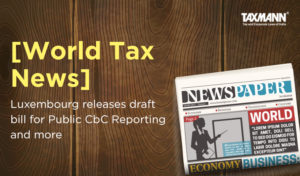[World Tax News] Luxembourg releases draft bill for Public CbC Reporting and more
- Blog|News|International Tax|
- 2 Min Read
- By Taxmann
- |
- Last Updated on 4 March, 2023
Editorial Team – [2023] 148 taxmann.com 78 (Article)
World Tax News provides a weekly snippet of tax news from around the globe. Here is a glimpse of the tax happening in the world this week.
1. Luxembourg releases draft bill for Public CbC Reporting
Luxembourg government has presented a draft bill in parliament for introducing Public Country-by-Country (CbC) reporting.
The draft bill aligns with the Directive (EU) 2021/2101, specifying a reporting threshold of annual consolidated revenue of EUR 750 million in each of the past two consecutive financial years. The public CbC report must be made available to the public for free within 12 months after the relevant year’s close, either on the website of the ultimate parent, relevant subsidiary, or branch.
However, Luxembourg is also taking the option provided in the Directive that the public CbC report does not need to be published on the website of the parent/subsidiary/branch if the public CbC report has been submitted and published on the Trade and Companies Register website.
The current draft mandates Public CbC reporting for financial years starting on or after 22nd June 2024.
Source: Bill 8158
2. New Zealand has released new guidance on tax avoidance and the interpretation of GAAR
The New Zealand Inland Revenue has issued a new Interpretation Statement (IS) 23/01 that pertains to the interpretation of the General Anti-Avoidance Provisions (GAAR) contained under Sections BG 1 and GA 1 of the Income Tax Act 2007. This new guidance replaces a prior interpretation statement issued by the Govt. in the year 2013, namely IS 13/01.
The guidance explains the Commissioner’s view of the law on tax avoidance in Aotearoa, New Zealand and is grounded on the Supreme Court’s stance as expressed in Ben Nevis Forestry Ventures Ltd. v. Commissioner of Inland Revenue [2008] NZSC 115.
The guidelines outline the method that the Commissioner employs to implement Section BG 1, and it also details how the Commissioner can take action under Section GA 1 to neutralize any tax benefit that an individual derives from or via a tax avoidance scheme.
The statement is also relevant to the general anti-avoidance provision in the Goods and Services Tax Act 1985
Source: Interpretation Statement
Click Here To Read The Full Article
Disclaimer: The content/information published on the website is only for general information of the user and shall not be construed as legal advice. While the Taxmann has exercised reasonable efforts to ensure the veracity of information/content published, Taxmann shall be under no liability in any manner whatsoever for incorrect information, if any.

Taxmann Publications has a dedicated in-house Research & Editorial Team. This team consists of a team of Chartered Accountants, Company Secretaries, and Lawyers. This team works under the guidance and supervision of editor-in-chief Mr Rakesh Bhargava.
The Research and Editorial Team is responsible for developing reliable and accurate content for the readers. The team follows the six-sigma approach to achieve the benchmark of zero error in its publications and research platforms. The team ensures that the following publication guidelines are thoroughly followed while developing the content:
- The statutory material is obtained only from the authorized and reliable sources
- All the latest developments in the judicial and legislative fields are covered
- Prepare the analytical write-ups on current, controversial, and important issues to help the readers to understand the concept and its implications
- Every content published by Taxmann is complete, accurate and lucid
- All evidence-based statements are supported with proper reference to Section, Circular No., Notification No. or citations
- The golden rules of grammar, style and consistency are thoroughly followed
- Font and size that’s easy to read and remain consistent across all imprint and digital publications are applied








 CA | CS | CMA
CA | CS | CMA


